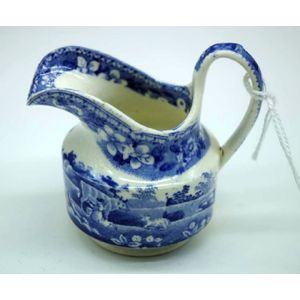Wedgwood Pearlware Boat Jug with Gilt Enhancements
You must be a subscriber, and be logged in to view price and dealer details.
Subscribe Now to view actual auction price for this item
When you subscribe, you have the option of setting the currency in which to display prices to $Au, $US, $NZ or Stg.
- Circa - A Latin term meaning 'about', often used in the antique trade to give an approximate date for the piece, usually considered to be five years on either side of the circa year. Thus, circa 1900 means the piece was made about 1900, probably between 1895 and 1905. The expression is sometimes abbreviated to c.1900.
- Pearlware - Pearlware is a type of earthenware pottery that was developed in the late 18th century in England, made from a mixture of clay, flint, and other materials, and is distinguished by its smooth, creamy white glaze. The glaze has a pearlescent quality, which is how the pottery got its name.
Pearlware was developed as a more affordable alternative to porcelain, which was much more expensive and difficult to produce. It quickly became popular throughout England and Europe, and was exported to other parts of the world as well. It was particularly popular for making tableware, such as plates, bowls, and teapots, as well as decorative objects like figurines and vases.
One of the most distinctive features of pearlware is its blue decoration. Many pieces of pearlware were decorated with blue patterns or designs, often featuring pastoral scenes, floral motifs, or geometric patterns. The blue decoration was typically applied over the white glaze, which created a striking contrast and made the designs stand out. - Cross Hatching - A decorative technique used in art, decorative arts, gilded frames and furniture to indicate light and shade through sets of parallel lines crossing each other at an oblique or right angle. The lines can be incised or engraved, as on metalware and ceramics, drawn or painted as in works of art and ceramics, or carved or applied as in furniture and mirrors. When used in art, the lines are usually very close together, whereas when used on ceramics, frames or furniture the lines may be much further apart effectively creating a square or diamond shape, which may contain further decoration.
This item has been included into following indexes:
-
Wedgwood (England), item types
- jugs and ewers 236
- vases and ewers 251
Visually similar items

A Wedgwood jug, circa 1810-1820, of low oval form with a slightly pinched pouring rim and a foliate ear shaped handle, decorated in underglaze blue with overpainting in iron red with gilt in a fine Chinoiserie floral pattern with birds; impressed marks inc

Good Chinese famille rose gravy boat, 9 cm high.

Spode 'Milkmaid' pattern miniature jug, 7 cm high. Printed 'Spode' mark to base.

A Worcester porcelain blue and white sauce boat, English, circa 1775, 8.5 cm high. Provenance: Christie's, Melbourne, 24 June 1996
